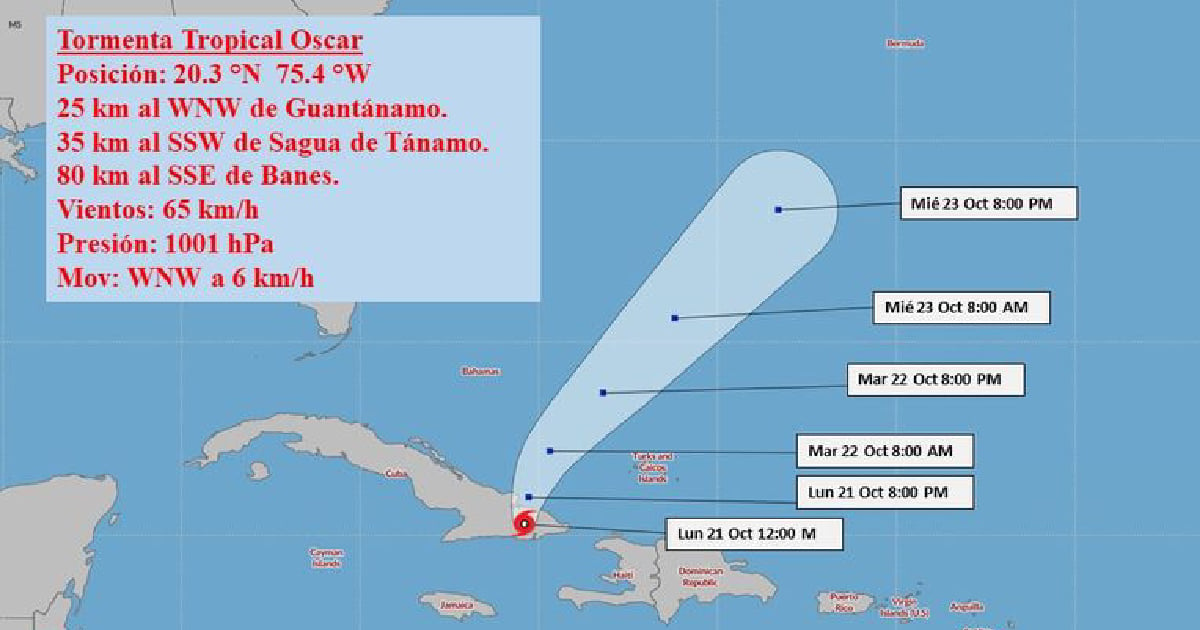
Tropical storm Oscar is moving slowly over the eastern tip of Cuba, heading west-northwest, but will continue to batter much of the region with rain, showers, and thunderstorms, reported the Cuban Institute of Meteorology (INSMET) in its latest bulletin, issued at noon this Monday.
The weather system, which made landfall near Baracoa at 5:50 PM on Sunday as a category 1 hurricane, has struck hard in several municipalities of the Guantánamo province, causing flooding and damage to more than a thousand homes, according to reports from local authorities.
As it moves slowly through the eastern region of Cuba, the now tropical storm continues to weaken. Its maximum sustained winds have dropped to 65 kilometers per hour, and its minimum central pressure has risen to 1001 hectopascals, according to Tropical Cyclone Advisory No. 13 from INSMET.
Oscar is moving west-northwest at only six kilometers per hour, and throughout the rest of the day, it will gradually tilt its trajectory to the northwest.
The Forecast Center indicated that the strongest precipitation cores linked to this meteorological system have spread to the province of Holguín, while remaining over Guantánamo and its adjacent seas.
Rain, showers, and thunderstorms will continue to affect a large part of the eastern region in the coming hours of the day, and they will remain strong and intense in some localities and mountainous areas.
Meanwhile, the winds will decrease as Oscar continues to weaken, and could reach speeds between 45 and 60 kilometers per hour, with higher gusts.
Similarly, strong swells will continue to register on the northern coast of the provinces of Guantánamo, Holguín, and Las Tunas, with coastal flooding in low-lying areas of this coastline, including the waterfront of Baracoa.
In the province of Guantánamo, more than 300 millimeters (around 12 inches) of rainfall have been recorded due to the passage of Oscar.
The National Hurricane Center (NHC) of the U.S. warned that "heavy rains are the main danger of the tropical storm, with potentially deadly flash floods and landslides in areas of eastern Cuba."
By Wednesday morning, between 180 and 350 millimeters (7 to 14 inches) of rain are expected, with isolated amounts of 500 millimeters (20 inches) in eastern Cuba, especially in the Sierra Maestra. These rains can cause significant flooding that could endanger lives, in addition to landslides, the NHC Advisory No. 10 noted.
Oscar is expected to leave Cuban territory during this afternoon or in the evening. However, the rain could continue persistently over the eastern region.
Below, we reproduce in full Tropical Cyclone Bulletin No. 13 regarding Tropical Storm Oscar:
FORECAST CENTER, INSMET.
Date: October 21, 2024. Time: 12:00 PM.
TROPICAL CYCLONE WARNING No. 13.
TROPICAL STORM OSCAR.
…Oscar is moving slowly toward the west-northwest…
Tropical storm Oscar has continued to weaken over the eastern region of Cuba, with its maximum sustained winds decreasing to 65 kilometers per hour and its minimum central pressure rising to 1001 hectopascals. The strongest precipitation cores associated with this system have extended to the province of Holguín and remain over Guantánamo and its adjacent seas.
The center of the tropical storm at noon was estimated at 20.3 degrees North latitude and 75.4 degrees West longitude, a position that places it 25 kilometers west-northwest of the city of Guantánamo, 35 kilometers south-southwest of Sagua de Tánamo, and 80 kilometers south-southeast of Banes, both locations in Holguín.
Oscar is moving slowly toward the west-northwest at just six kilometers per hour. Throughout the rest of today, this system will gradually tilt its trajectory to the northwest.
In the coming hours, rain, showers, and thunderstorms will persist affecting much of the eastern region, which will continue to be strong and intense in some areas and in the mountainous zones.
In the eastern provinces, the winds will decrease with the weakening of Oscar, which can reach speeds between 45 and 60 kilometers per hour, with higher gusts.
Strong swells will continue along the northern coast of the provinces of Guantánamo, Holguín, and Las Tunas, with coastal flooding in low-lying areas of this coastline, including the waterfront of Baracoa, which will gradually diminish throughout the rest of the day today.
The greatest attention must be paid in the eastern provinces to the evolution and future path of tropical storm Oscar, particularly to the occurrence of intense rainfall, which can cause flooding in these provinces.
The next tropical cyclone notice will be issued at three o'clock this afternoon.
What do you think?
COMMENTFiled under: